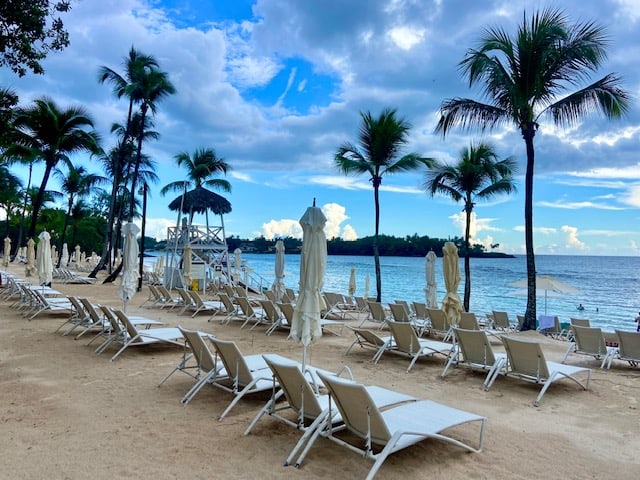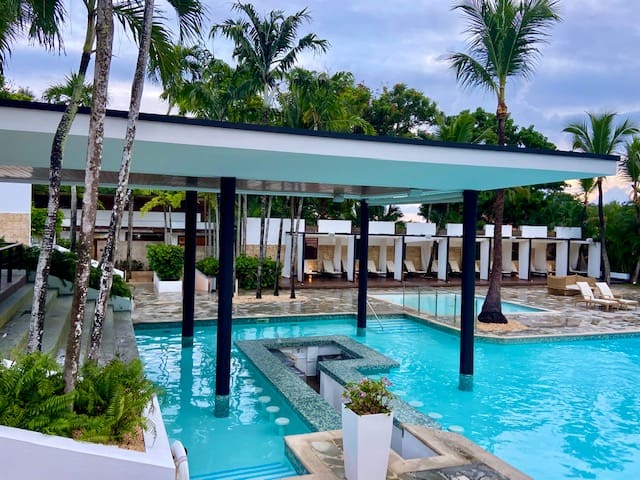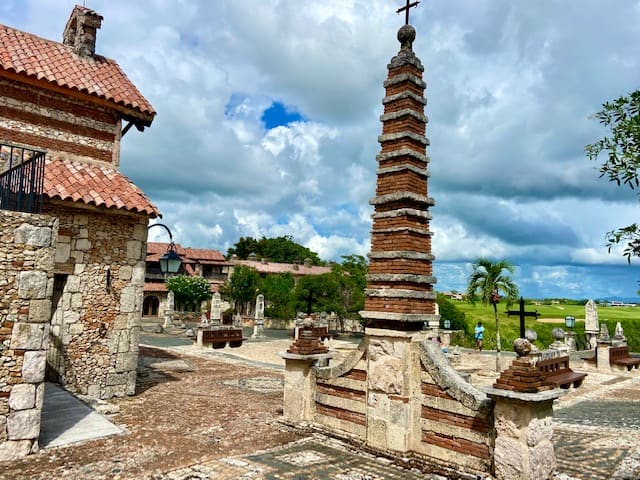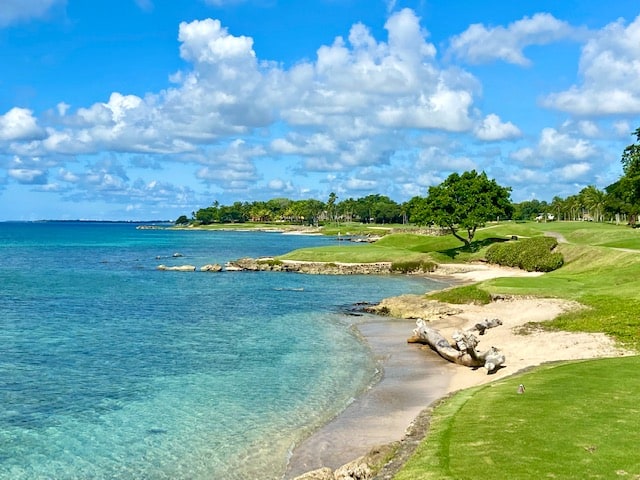

I began to let my mind wander across some of the destinations in which I’d experienced some situational sweetness.
Considering that Hollywood’s most memorable movie romances are ones in which the participants do not end up together “happily ever after,” I began, in a series of columns, to let my mind wander across some of the destinations in which I’d experienced some situational sweetness. I’m not talking torrid times, but rather, relationships that weren’t going to get any better than they were during those golden moments at destinations designed to steal your heart.
Casa de Campo
What I love about Casa de Campo Resort and Villas, near La Romana in the Dominican Republic, is the excitement of knowing that each day can be so very different from the last. I experienced this in a romantic lightning bolt that struck during an already satisfying sunny sunset. More on that in a moment.
But why is the Casa de Campo experience so varied? It’s because the resort’s luxury offerings are spread out and staged in not only different places but entirely different settings – and all of them open-air to embrace the warm, tropical reason you came – or moved – to Casa de Campo. These resort areas are populated by a variety of people: business titans who arrived by Learjet; sailors who came via cabin cruiser; golf aficionados who’ve made a pilgrimage to challenge the Pete Dye-designed Teeth of the Dog course; the betrothed and honeymooners; and more.

The variety of voyagers not only have the option of three completely different scenic golf courses but also to shop, dine and discover entertainment in the gardens of a Mediterranean medieval village; feel as if they’re lost on a desert island with the comfort of a beach club. Unlike crowded beach destinations like Cancun, Rio or Miami, Casa de Campo has no high-rise buildings and in terms of population is very low-density.
Guests who don’t want sand in their toes can also socialize in glamorous, designer swimming pool settings; and stroll with a Cuban cigar through a marina setting that feels closer to Portofino than Punta Cana.
There is a sense that anything can happen. And it can.

Perusing the Property
Casa de Campo, which translated from Spanish means “country house,” is not your ordinary golf destination. It is 7,000 acres of homes, hotel rooms and holes of golf both along the Caribbean Sea and also high above the property over the Chavon River. Everything about the resort is dramatic and chic with a thick sense of international intrigue in the air. The homeowners, hotel guests, marina boaters and staff who populate the enclave come from around the globe to put their feet up, lace up their soft spikes, or lift a mojito to celebrate sunsets in an infinity pool looking over the beach.
You’ll overhear a symphony of different languages bouncing between Spanish, Italian, Portuguese, French Canadian, German, English and more blowing in the breeze under sunny skies. The resort’s staff of internationally intriguing golf professionals come from as far and wide as Canada, Argentina, Italy, Wisconsin and San Diego under the direction of Robert Birtel from New Orleans. The head caddie master is from Puerto Rico.
Calories and Cuisine
Polo, riding, shooting, spa-going, golf, tennis, swimming and shopping are part of the Casa de Campo experience on a gated property so expansive that hotel guests are given golf carts to maneuver between amenities. Getting some steps in on the golf courses, or laps in the pools or warm sea, is a good idea given the quality culinary choices available throughout the resort. Sometimes hotels and all-inclusive resorts, particularly properties on islands, serve substandard food or average fare. Not Casa de Campo, which serves a wide variety of international gourmet choices at restaurants with completely varied atmospheres.

Chilango Taqueria overlooks the cobblestone Plaza Chavon and its church-front fountain in the replica 16th century Medieval village of Altos de Chavon, which is a popular scenic spot for weddings and especially wedding photos. The casual restaurant serves Mexican street food in view of blanketed donkeys and artists selling their jewelry and wares.

La Piazzetta is in that ornate. Altos de Chavon setting high above the river, too. Casa de Campo’s first restaurant was designed by Oscar de la Renta and embraces the major influence Italian immigrants infused in the La Romana area.

Minitas Beach Club and Restaurant is the premium spot for sunset on the sand and along the infinity pool deck. You might catch sight, through the blowing, white linen curtains of the cabanas, of an occasional ocean-liner cruising by. In that sophisticated setting try the octopus carpaccio; duck confit; ossobuco; prawn and avocado salad; mango gazpacho; tropical ceviche; Iberian pizza; chicken and pork paella; or Mediterranean branzino in addition to many other unique dishes.
La Casita and SBG elegantly serve ocean-to-table seafood in seafront settings.
La Cana serves French-inspired fare with live music, hand-rolled cigars and Dominican rums. Causa serves Peruvian food in the creole, Nikkei and Chifa style.
Breakfast at Lago allows for pre-round views of the famed Teeth of the Dog golf course or a peek at other players finishing their rounds during lunch after the round.

Celebrity Swank
One is wise to keep their eyes open for celebrities, too, since the likes of Jay-Z, Beyonce, A-Rod, J-Lo, Derek Jeter, the Kardashians, Drake, Rihanna, Michael Jordan, Dennis Quaid, and many others have enjoyed the stylish luxury of Casa de Campo’s Minitas Beach Club; yacht-filled marina, and Altos de Chavon Mediterranean artist’s colony with its coliseum amphitheater opened with a performance by Frank Sinatra. Ol’ Blue Eyes was known as the Chairman of the Board, and Commanders in Chief have caucused at Casa de Campo as well including U.S. Presidents George H.W. Bush, Bill Clinton, and George W. Bush
Stylish, swank and sophisticated architecture throughout the resort makes everyone feel like they’re on-stage in surroundings that feel like movie sets. And sometimes they are. “Apocalypse Now,” starring Marlon Brando, Robert Duvall and Martin Sheen famously filmed jungle scenes on the Chavon River in the shadows of Altos de Chavon.
Casa de Campo is a headlining resort that is a star in itself, much like hotels that make enduring appearances in television shows like Four Seasons Maui HBO’s “White Lotus” or the Turtle Bay Resort in “Forgetting Sarah Marshall,” or Miami’s Fontainebleau Hotel in the 007 flick “Goldfinger.”

Starring…You!
Straight out of central casting is Montreal native Gilles Gagnon, the French Canadian who was a professional hockey player in the early 1970’s but traded scoring goals for sinking putts by skating into the position as golf professional at Casa de Campo Resort. He now keeps all of the resort’s secrets as Casa de Campo’s golf professional emeritus and special golf ambassador. One of the secrets is the exact burial spot of a golf world legend.
Gagnon is loved and respected throughout the golf world as is his late friend Pete Dye who designed the famed Teeth of the Dog and the resort’s other scenic golf courses including the Links Course and the dramatic Dye Fore course.
“Without proper heavy machinery to crack the coral the tireless Dominican crew used sledgehammers, pickaxes and chisels. The result is a true masterpiece with seven holes created by God,” wrote Dye in his autobiography.
Dye also created landmark PGA Tour courses such as TPC Sawgrass; Whistling Straits and Harbor Town, chose to live, die and be buried at Casa de Campo.
The title of Dye’s autobiography “Bury Me in a Pot Bunker,” was fulfilled by his surviving family members and Gagnon, who took the ailing Dye for a sunset cart ride near the bunker in question on the golf course during his final days. “Pete looked across at the sea and I told him, ‘You’ve really done good, my friend.’ The moment provoked a smile and a tear in his eye.”

The Love Boat
I met Gagnon 17 years ago while traveling with my eight-year-old son Harrison aboard a Windstar sailing cruise bound for Casa de Campo. I was one of about 120 passengers who’d boarded the sleek, four-masted sailing ship in San Juan and made golf courses and spa stops in St. Barth’s and Nevis. During a day at sea Gagnon stood on the teak deck and gave, in his French-Canadian accent, a presentation on the golf courses of the Caribbean, particularly the dynamic Dye courses created at Casa de Campo – especially the Teeth of the Dog course.
“If you dare to challenge the ‘Dog’ at some point in your game this Dog WILL bite you…guaranteed,” Gagnon warned with a grin.
I liked him immediately, but I also came to enjoy the casual company of an intriguing French named Elisabeth who was cruising solo with Gagnon and his wife Merrilee. Elisabeth, and her suntanned aura, reminded me of Jacqueline Kennedy Onassis. She spoke to me with an accent from behind her ever-present designer sunglasses and her slender self was always outfitted in perfectly-pressed haute couture.
Our spontaneous conversations were exclusively limited to watching the waves while standing at the ship’s rail apart from the others while Elisabeth enjoyed the occasional slender cigarette. I’d like to paint the picture of the mysterious, glamorous woman drawing smoke through a long cigarette holder, but I suspect that is a supplement of my romantic, creative imagination years later.
Ours were polite conversations of convenience since we were unaccompanied adults both single, shipboard and solo. I liked Elisabeth’s edge but she was friendly. As intrigued as I was, I remained careful to respect the space of a person who’d surely come to value the solitude of a cigarette as a moment of meditation. She was not the type of person I would normally meet, but that’s what Casa de Campo is all about.
Matchmaker
One afternoon Gagnon and I stood on deck watching the wind in the sails as the Windstar ship slipped closer to Casa de Campo. It was the home port of Gagnon and his wife Merrilee, who, of course, lived at the resort development as did Elisabeth, who owned a home there.
“You seem to be getting along with our friend Elisabeth,” Gagnon mentioned to me.
“She is definitely an intriguing woman,” I answered.
“You should come spend some time at Casa de Campo. Get to know her,” he suggested.
“You think so?”
“Yes,” Gagnon said. “You’d be good for her. What Elisabeth really needs is someone to show her that life is not all about being rich.”
“Oh?”
“Yes,” he said. “She’s worth about one-hundred-million dollars.”
I wish, to this day, I could have seen the reaction on my own face.
“Gilles,” I recovered and replied, “If Elisabeth really needs what you said then we are definitely a perfect match. Opposites attract!”
We both laughed…and are still laughing about it to this day.
Read more on Michael Patrick Shiels’ travel blog, The Travel Tattler. Contact Travel Writer Michael Patrick Shiels at [email protected]
- e.baldi is Beverly Hills Best Italian Dining Delicacy - April 23, 2024
- Ashford Castle Hotel, U2’s Bono and Why Visting Ireland is So Entertaining - March 28, 2024
- Solo Travel to Oceania Cruise Ports St. Barth’s and Barbados Became Authentic Cultural Encounters - February 27, 2024
